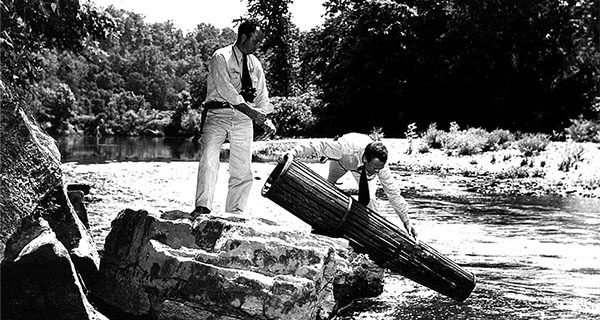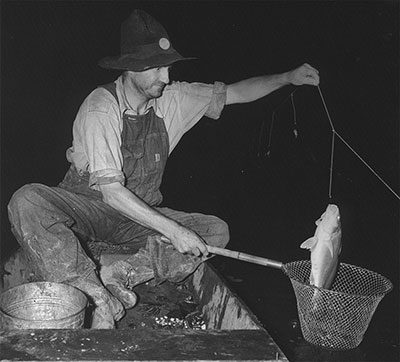
Tennessee has a long history of fishing that does not necessarily involve traditional bait and tackle. We often imagine the modern angler with an expensive boat or hundreds of dollars invested in waders, not to mention the garage full of gear. However, when times were simpler, anglers fished to put food on the table using whatever means they could. Many of these methods were developed before reservoirs altered Tennessee’s landscape. River fishing was all that was available, and anglers pursued abundant fish like suckers, buffalo, and catfish. Some of the more notorious methods including the use of explosives, poisons, electricity, or firearms, have since been banned to protect fish populations, the public, as well as the angler. In recent years, some primitive approaches like archery and hand grabbling have returned to popularity. Many legal methods are still available for the Tennessee sportsman wanting to broaden their tackle box. Since these techniques enable the angler to harvest large quantities of fish in a single trip, the use of these devices are more strictly regulated than typical fishing gear. For the sake of brevity, this article will focus on just a few methods other than rod and reel.
SLAT BASKETS
Fish traps are perhaps the oldest method of fishing, while ancient cultures used several types of fish traps, the slat basket (or slat trap) is one contemporary still used in Tennessee and that remains commercially available.
Slat baskets can be constructed from wood, cane, or modern plastic materials. The design is fairly simple, with one end acting as a throat to funnel fish into the other end called the catch area. Regulations state that in order to allow smaller fish to escape, there must be at least four openings in the catch area measuring 1 ½ inches by 6 inches long. Instructions on making baskets can readily be found online, or they can be purchased from tackle shops for under $100. Slat baskets cannot be used within 100 yards of the mouth of a river, creek, or slough. Regardless of where anglers get their basket, anglers can only fish one at a time, and a metal slat basket tag must be purchased annually from TWRA.
Most slat baskets are used to catch catfish, but will catch redhorse and other suckers as well. Only nongame fish and catfish species can be harvested from a slat basket. There are a variety of options and homebrews for bait, but the most common are waste cheese, cut-bait, dog food, soap, and soybean meal. The bait should be placed in a mesh bag to keep trapped fish from eating the bait too quickly. A well-placed and well-baited slat basket will easily pack a cooler.

TROTLINES
Hank Williams Jr once immortalized running a trotline as a rite of passage for rural culture (among other pursuits). Trotlines are pretty simple, consisting of a mainline attached to the bank or a float with baited droppers every few feet. Trotlines are chiefly used to catch catfish, but anglers should be prepared for a little bit of everything. Trotlining is one of the few “methods other than” where gamefish may be kept according to local limits.
Any meaty bait normally used for catfishing works for trotlining as long as it is durable. Nickel to quarter-sized chunks of cut bait is ideal, but anglers can opt for larger hooks and larger baits if they want to target big fish. Any type of hook is legal, but experienced trotliners go with a size 2/0 – 4/0 circle hook or a straight shank to decrease costs. Most trotlines have at least 210 pound braided nylon with a 150 pound dropper. Although a modern addition, heavy duty swivels attaching each dropper to the mainline will allow hooked fish to spin rather than tangle. Some trotlines are fished suspended in the water column, but this takes a little more practice and adds to the cost of the setup.
An angler cannot exceed 100 hooks at a given time, whether that is on single or multiple trotlines, and droppers must be at least 24 inches apart. Trotlines can be tied to the bank or attached to a float; however, each trotline has to be marked/tagged with the owner’s name and address or TWRA identification number. Trotlines cannot be used within 1,000 yards of a dam or 100 yards from the mouth of a river, creek, or slough. Trotlines must be checked at least once per day, but a good spot will yield buckets full of catfish in a morning or afternoon if you don’t have time to run a trotline camp like they did in the old days.
SNAGGING
Each year, massive schools of fish congregate on the swift and clean river shoals in an effort to produce another generation of offspring. Spawning runs normally start with the first big rain event in February and can last until early May. Most rivers produce a healthy run of native redhorse, suckers, and buffalo, but the best will be so plentiful you would think it possible to walk across their backs to the other bank.
Snagging, the process by which fish are taken by a hook (most commonly a large treble) with a swift jerking motion, is often employed during spawning runs. Historically, snagging large river shoals or creek pools for redhorse, buffalo, and suckers was very common. This tactic may appear distasteful to some at first glance. However, it is a long practiced tradition in many communities and most fish caught using this tactic are eaten and not wasted. Several rivers, or portions thereof, are seasonally protected for sensitive spawning runs.
Back in the 1940s, TWRA (then the Tennessee Game and Fish Commission) even operated a redhorse hatchery in Shelbyville to support a local “shoal fishermen association”. Most shoals are clear enough that anglers can identify the individual species from the bank, and will cast to a particular fish. Fishing too soon after a heavy rain may be difficult because of muddy and swift waters. In the past, some nimble anglers would dangle from trees and merely lift the hook into the rooter (mouth) as a fish would pass by. Typically, few gamefish are inadvertently snagged, but if caught, they must be released. All anglers need to get started is a large treble hook (3/0 to 10/0), a heavy sinker tied about 18” behind the hook, 20-50# braided line or monofilament, and a stiff rod. Some anglers paint their hook shank white or tape the shank for better visibility. Using this method anglers are most likely to catch several 2-10 pound fish that make excellent table fare.

Some anglers use even heavier tackle to try snagging paddlefish (sometimes called spoonbill cats) downstream of large river dams. Since paddlefish are long-lived, reach giant sizes, and are very susceptible to overfishing, their harvest is heavily regulated: a limited season (April 24 – May 31), daily creel of 2 fish, culling is prohibited, and local closures exist in several tailwaters. Again, check the Fishing Guide for regulations as they do change periodically. Paddlefish yield a great deal of meat and their eggs are said to taste similar to caviar.
PREPARATION
Regardless which style you try, if done correctly, a skilled angler will likely be able to catch more fish than can be eaten at once. While old time anglers certainly enjoyed running a trot line or snagging a shoal for redhorse, at the end of the day they were working to feed their families. Most anglers today are picky and eat only a few species of fish because they are easier to clean and require less preparation (i.e., crappie and walleye). However, with a little practice and work, many of the less desirable nongame species can still be quite delicious. Redhorse, white sucker, freshwater drum, and buffalo have thick scales and Y bones that need to be removed, but proper cleaning will make it worth your while. A fish can be scaled in seconds and working around the bones requires a little elbow grease and a bit more time.
Wondering what to do with your pile of sucker or catfish fillets? Prior to refrigeration—which was not widely available until 100 years ago—fish had to be salted, iced, pickled, canned, or simply eaten fresh. Preserving fish helped early Tennesseans have access to a high protein food source throughout the year. Consider the timeworn, yet simple method of canning to preserve your catch. Canning fish has been around for nearly 200 years and many settlers would have brought that skill with them crossing the Appalachians. These fish do not need to be drowned in spices to be enjoyed. They are delicious on their own. Try these straightforward yet delicious recipes listed below. They are sure to turn your canned redhorse into tasty morsels your great grandfather would have enjoyed.
Many hunters enjoy hunting with black powder or primitive archery as a nod to their forefathers and the challenge. Go ahead, be adventurous, try a method other than rod reel to get in touch with the traditions of the past, and become a Tennessee sportsman.